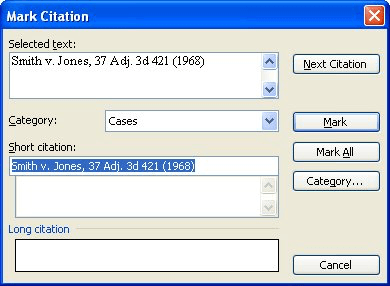Please Note: This article is written for users of the following Microsoft Word versions: 97, 2000, 2002, and 2003. If you are using a later version (Word 2007 or later), this tip may not work for you. For a version of this tip written specifically for later versions of Word, click here: Creating a Table of Authorities.
Written by Allen Wyatt (last updated September 22, 2018)
This tip applies to Word 97, 2000, 2002, and 2003
In long legal documents, a table of authorities is often used to cite references to statutes, cases, and other sources for information referenced in the document. The table of authorities will cite the case or statute, along with the page number in the document on which the case or statute is referenced.
Word includes the ability to easily create a table of authorities. You do so by first marking citations within your document, and then instructing Word to compile the citations into your final table. As you are marking citations, you can specify both long and short versions of citations. For instance, a long citation may be something like "Smith v. Jones, 37 Adj. 3d 421 (1968)." The short version of the citation could be something like "Smith v. Jones" or even "Smith (1968)."
To mark citations, follow these steps:

Figure 1. The Mark Citation dialog box.
WordTips is your source for cost-effective Microsoft Word training. (Microsoft Word is the most popular word processing software in the world.) This tip (900) applies to Microsoft Word 97, 2000, 2002, and 2003. You can find a version of this tip for the ribbon interface of Word (Word 2007 and later) here: Creating a Table of Authorities.

Do More in Less Time! An easy-to-understand guide to the more advanced features available in the Microsoft 365 version of Word. Enhance the quality of your documents and boost productivity in any field with this in-depth resource. Complete your Word-related tasks more efficiently as you unlock lesser-known tools and learn to quickly access the features you need. Check out Microsoft 365 Word For Professionals For Dummies today!
Automatically create a Table of Authorities entry in your document, and Word might place the necessary field at the wrong ...
Discover MoreWith the entries for your table of authorities marked throughout your document, you are ready to actually generate the ...
Discover MoreA table of authorities is normally divided into separate sections based on categories you define. Here's how to create ...
Discover MoreFREE SERVICE: Get tips like this every week in WordTips, a free productivity newsletter. Enter your address and click "Subscribe."
There are currently no comments for this tip. (Be the first to leave your comment—just use the simple form above!)
Got a version of Word that uses the menu interface (Word 97, Word 2000, Word 2002, or Word 2003)? This site is for you! If you use a later version of Word, visit our WordTips site focusing on the ribbon interface.
Visit the WordTips channel on YouTube
FREE SERVICE: Get tips like this every week in WordTips, a free productivity newsletter. Enter your address and click "Subscribe."
Copyright © 2026 Sharon Parq Associates, Inc.
Comments